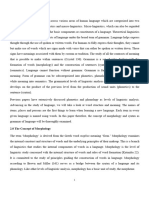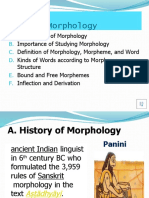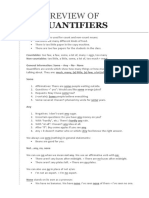Lex 010 Morpheme
Lex 010 Morpheme
Uploaded by
angli4annkaCopyright:
Available Formats
Lex 010 Morpheme
Lex 010 Morpheme
Uploaded by
angli4annkaOriginal Description:
Copyright
Available Formats
Share this document
Did you find this document useful?
Is this content inappropriate?
Copyright:
Available Formats
Lex 010 Morpheme
Lex 010 Morpheme
Uploaded by
angli4annkaCopyright:
Available Formats
Lex_010_Morpheme
THE MORPHEME
Outline:
I. Definition
II. Semantic classification of morphemes
III. Structural classification of morphemes
IV. Allomorphs
Key words: morpheme, semantic classification (root-morpheme, non-root /
affixational morpheme, unique / pseudo- / blocked root morpheme, derivational affix,
functional affix / inflectional morpheme / inflection), structural classification (free
morpheme, bound morpheme, semi-free / semi-bound morpheme, combining form /
completive), allomorph / morpheme variant (complementary distribution / alteration).
I. Definition
Morpheme is the smallest indivisible two-facet language unit. Morphemes, though
they are as a rule easily singled out in words, are not independent and are found only as
parts of the word. Morphemes can be classified: a) from the semantic point of view; b)
from the structural point of view.
II. Semantic classification of morphemes
Semantically morphemes fall into 1) root-morphemes and 2) non-root morphemes /
affixational morphemes.
1) The root-morpheme is the lexical nucleus of the word, it has an individual lexical
meaning shared by no other morpheme of the language. Besides the lexical meaning root-
morphemes possess all other types of meaning proper to morphemes except the part-of-
speech meaning which is not found in roots. The root-morpheme is common to a word-
cluster, e.g. the morpheme to teach–, in teacher, teaching or theor- in theory, theorist,
theoretical, etc.
Those root morphemes which never occur by themselves are called unique, pseudo-
or blocked root morphemes. E.g. theor- in theory, theorist, theoretical or Fri- in Friday, or
cran- in cranberry.
2) Non-root morphemes include functional affixes / inflectional morphemes /
inflections and derivational affixes.
Inflections carry only grammatical meaning and are thus relevant only for the
formation of word-forms, whereas affixes are relevant for building various types of stems
– the part of a word that remains unchanged throughout its paradigm. Lexicology is
concerned only with affixes.
Derivational affixes are classified into prefixes and suffixes: a prefix precedes the
root-morpheme, a suffix follows it.
III. Structural classification of morphemes
Structurally morphemes fall into three types: 1) free morphemes, 2) bound
morphemes, and 3) semi-free (semi-bound) morphemes.
1
Lex_010_Morpheme
1) Free morphemes coincide with word-forms of independently functioning words.
Free morphemes can be found only among roots, so the morpheme boy- in the boyhood or
the morpheme friend– in the noun friendship are free morphemes because they coincide
with the corresponding nouns boy and friend. In the word undesirable there is only one
free morpheme desire-; the word pen-holder has two free morphemes pen- and hold-,
fancy-dress-maker has three free morphemes.
2) Bound morphemes do not coincide with separate word-forms and occur only as a
constituent part of a word. All affixes are bound, such as derivational suffixes -ness, -able,
-ship, -er, -ize or prefixes un-, dis-, de- (as in readiness, enjoyable, kinship, teacher, to
activize; and unnatural, to displease, to decipher).
3) Semi-bound / semi-free morphemes can function both as an affix and as a free
morpheme. E.g., the morpheme well and half on the one hand occur as free morphemes
that coincide with the word-form in collocations like to sleep well, half an hour, but on the
other hand they occur as bound morphemes in words like well-known, half-eaten, or half-
done.
4) Root-morphemes may be both free and bound. All unique roots are bound. The
morphemes theor- in the words theory, theoretical, or horr- in the words horror, horrible,
horrify; Angl-in Anglo-Saxon; Afr- in Afro-Asian; Fri- in Friday, or cran- in cranberry are
all bound roots as there are no identical word-forms.
5) A combining forms or completives are bound root-morphemes of a special kind.
Completives were borrowed from another language, mostly Greek or Latin. They
differ from all other borrowings because they occur in compounds and derivatives that did
not exist in the original language but were formed only in modern times (e.g. polyclinic,
stereophonic, television, etc.).
They should be distinguished from an affix because a) completives do not possess the
part-of-speech meaning typical of affixational morphemes; b) completives can occur as
one constituent of a word whose only other constituent is an affix (e.g. graphic, cyclic,
aerate, aerobatics, etc.); assuming that completives are affixes would lead to the
conclusion that words of this group contain no root-morpheme and are composed of a
suffix and a prefix which runs counter to the fundamental principle of word-structure; c)
an affix is characterized by its position to the stem, either before the stem (prefix) or after
the stem (suffix), whereas the same combining form may occur in both positions (e.g.
phonograph, microphone).
IV. Allomorphs
Morphemes may have different phonemic shapes. In the word-cluster please,
pleasing, pleasure / pleasant the root-morpheme is represented by phonemic shapes:
[pli:z] in please, pleasing, [pleZ] in pleasure, and [plez] in pleasant. In such cases the
phonemic shapes of the word stand in complementary distribution / in alternation with
each other. All the representations of a morpheme are called allomorphs / morpheme
variants. Thus [plez], [pli:z] and [pleZ] are allomorphs of the same morpheme. The word-
cluster duke, ducal, duchess, duchy or poor, poverty are also examples of allomorphs of
one morpheme.
You might also like
- Lecture 2 - Morphological Structure of An E.wordNo ratings yetLecture 2 - Morphological Structure of An E.word5 pages
- Suffixation. I Prefixation. I: Morphe RN RNNo ratings yetSuffixation. I Prefixation. I: Morphe RN RN20 pages
- Topic 1. Morphology and Its Notions: 1. Language and Speech. Language Levels and Their Units. The Language IsNo ratings yetTopic 1. Morphology and Its Notions: 1. Language and Speech. Language Levels and Their Units. The Language Is5 pages
- Name: Yuliati Paramitha ID Number: 170705025 Subject: MorphologyNo ratings yetName: Yuliati Paramitha ID Number: 170705025 Subject: Morphology5 pages
- Morphology & Syntax As Grammar of LanguageNo ratings yetMorphology & Syntax As Grammar of Language32 pages
- The Morpheme: Morphemes Are Usually Represented by Their Graphic Form, or Spelling E.g., - EsNo ratings yetThe Morpheme: Morphemes Are Usually Represented by Their Graphic Form, or Spelling E.g., - Es25 pages
- The Morphological Structure of English WordsNo ratings yetThe Morphological Structure of English Words51 pages
- Distributional Types of Morphemes - Usyukevich - Bolotova - 1122No ratings yetDistributional Types of Morphemes - Usyukevich - Bolotova - 112212 pages
- Morphology: Based On Victoria Fromkin BookNo ratings yetMorphology: Based On Victoria Fromkin Book33 pages
- A Morpheme Is The Smallest Grammatical Unit in A LanguageNo ratings yetA Morpheme Is The Smallest Grammatical Unit in A Language2 pages
- General Linguistics: Morphology Word StructureNo ratings yetGeneral Linguistics: Morphology Word Structure45 pages
- перероблений семінар 2, ЛA-02, Grubiak YuliaNo ratings yetперероблений семінар 2, ЛA-02, Grubiak Yulia8 pages
- Morphological Structure of A Word. Word-Formation in Modern English 1. Give The Definition of The MorphemeNo ratings yetMorphological Structure of A Word. Word-Formation in Modern English 1. Give The Definition of The Morpheme22 pages
- Lecture 2. A word as a main lexicological unit. doc (1)No ratings yetLecture 2. A word as a main lexicological unit. doc (1)7 pages
- S5 Morphology & Syntax Manual Dr. EnnassiriNo ratings yetS5 Morphology & Syntax Manual Dr. Ennassiri64 pages
- Morpheme As The Smallest Meaningful UnitNo ratings yetMorpheme As The Smallest Meaningful Unit10 pages
- Morphology: Taken From Finegan, Chapter 2 (Pages 46-52) "Words and Their Parts"No ratings yetMorphology: Taken From Finegan, Chapter 2 (Pages 46-52) "Words and Their Parts"23 pages
- Unit 1 Types of Words and Word Formation ProcessesNo ratings yetUnit 1 Types of Words and Word Formation Processes23 pages
- English Syntax 2 - Representinf Sentence StructureNo ratings yetEnglish Syntax 2 - Representinf Sentence Structure14 pages
- Discuss The Questions.: Character AdjectivesNo ratings yetDiscuss The Questions.: Character Adjectives5 pages
- Comparing Analytical Exposition With HortatoryNo ratings yetComparing Analytical Exposition With Hortatory12 pages
- Colegio Jose Antonio Beltran-Sede A: Teen PowerNo ratings yetColegio Jose Antonio Beltran-Sede A: Teen Power17 pages
- Get Easier English Intermediate Dictionary 2nd Edition Peter Collin free all chapters100% (3)Get Easier English Intermediate Dictionary 2nd Edition Peter Collin free all chapters72 pages
- Lesson 4 - Transitive and Intransitive VerbsNo ratings yetLesson 4 - Transitive and Intransitive Verbs10 pages
- Chapter 2 (Introducing Oneself and Others, Spelling Aplhabet, Subjective & Objective Pronoun)No ratings yetChapter 2 (Introducing Oneself and Others, Spelling Aplhabet, Subjective & Objective Pronoun)8 pages
- Abdul Aziz - Identifying Parts of SpeechNo ratings yetAbdul Aziz - Identifying Parts of Speech1 page
- Writing: By: Maria Cecilia M. Genove, Ed. DNo ratings yetWriting: By: Maria Cecilia M. Genove, Ed. D50 pages
- 1.1 Present Simple and Present Continuous FinalNo ratings yet1.1 Present Simple and Present Continuous Final13 pages
- Unit / Chapter Lessons Overview: Semester 1No ratings yetUnit / Chapter Lessons Overview: Semester 14 pages
























































































